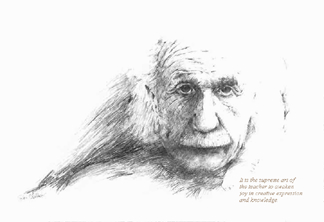The Einstein Connection
- ALBERT EINSTEIN -
1879-1955
"I came -- though the child of entirely irreligious (Jewish) parents -- to a deep religiousness, which, however, reached an abrupt end at the age of twelve. Through the reading of popular scientific books I soon reached the conviction that much in the stories of the Bible could not be true. The consequence was a positively fanatic orgy of freethinking coupled with the impression that youth is intentionally being deceived by the state through lies; it was a crushing impression. Mistrust of every kind of authority grew out of this experience, a skeptical attitude toward the convictions that were alive in any specific social environment -- an attitude that has never again left me."
Einstein appears unafraid to admit what he felt and thought, even if it flew in the face of established intellectual tradition. Concluding 'one of the least-known correspondences of the history of science', in January 1955, only months before his death, Einstein remarked that the:
"... gradualistic notions common in geology were ... merely a habit of mind, and were not necessarily justified by the empirical data."[1]
"A great many empirical data indicate that at each point of the earth's surface that has been carefully studied, many climatic changes have taken place, apparently quite suddenly. This, according to Mr. Hapgood, is explicable if the virtually rigid outer crust of the earth undergoes, from time to time, extensive displacement ..."[2]
Gradualistic theory - as opposed to catastrophism - has served to this day as the dominant paradigm to explain not only the origin and life of plants and animals, but that of the geology and paleontology of the planet.
To Einstein, the 'gradualistic notions' of geology were 'a habit of mind' and 'not necessarily justified by the empirical data'. Defying contemporaries and predecessors alike, Einstein went right to the heart again. The theory of earth crust displacement formulated by Charles H. Hapgood - which 'electrified' Einstein - has since gained critical acclaim and support from specialists in superficially unrelated fields.
"I find your arguments very impressive and have the impression that your hypothesis is correct. One can hardly doubt that significant shifts of the crust of the earth have taken place repeatedly and within a short time."[3]
In contrast to Einstein's enthusiasm for Hapgood's inherently catastrophic theory of crustal displacement, Charles Darwin went so far as to suggest that "he who can read Sir Charles Lyell's grand work on the Principles of Geology and yet does not admit how vast have been the past periods of time, may at once close this volume [Origin of Species]."
Darwin's suggestion was right. Empirical evidence suggesting sudden shifts of the earth's crust and significant climatic changes do not mix easily with the theory of evolution. Without the vast, uninterrupted ages of relative geological tranquility Darwin's theory requires for the evolution of species, the doors to his theory yawn wide open. Better close that book then, for now.
As for the mechanism that might dislocate the earth's crust from it's core, Einstein wrote:
"In a polar region there is a continual disposition of ice, which is not symmetrically distributed about the pole. The earth's rotation acts on these unsymetrically deposited masses, and produces centrifugal momentum that is transmitted to the rigid crust of the earth. The constantly increasing centrifugal momentum produced this way will, when it reaches a certain point, produce a movement of the earth's crust over the rest of the earth's body, and this will displace the polar regions toward the equator."[2]

- ALBERT EINSTEIN -
1879-1955
MORE ON EINSTEIN ...
OR follow Hapgood to:
The Treasure of Alexandria
Maps of the Ancient Sea Kings
[Albert Einstein; Eminent Soul] [Einstein; Lifeline] [Einstein; Accomplishments] [The Einstein Connection] [Apocalypse Aerie] [Ancient Maps] [Earth Crust Displacement] [Myths of Catastrophism] [History & Science in Myth] [Egypt; The Call of the Sphinx] [India; A Cradle for Civilization] [America; Fear of the Dark] [World Ocean; Path to Atlantis] [Precession; Warning of the Ancients] [Epilogue & Links]
[View Guestbook] [View Old Guestbook] [Sign Guestbook] [ ]
[Home] [Other Work]
Copyright © Marc Bergvelt. 1998-2002. All Rights Reserved.
CLICK BACK ON BROWSER TO RETURN TO FOOTNOTE
[1] Albert Einstein, in Hapgood's Path of the Pole, 1970.
[2] Foreword to Earth's Shifting Crust by Charles H. Hapgood, 1958.
[3] Albert Einstein. Princeton, New Jersey. From a letter to Charles H. Hapgood, 8 May 1953.
[4] Letters to and from Hapgood: Read the Einstein-Hapgood Letters



